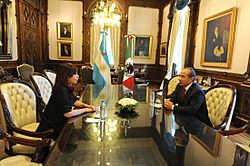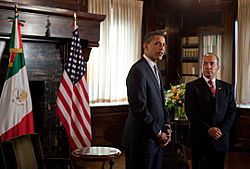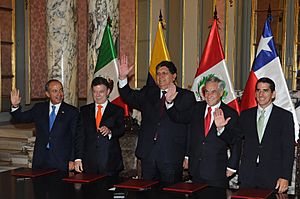Felipe Calderón facts for kids
Quick facts for kids
Felipe Calderón
|
|
|---|---|
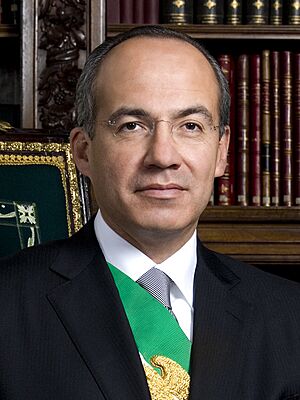
Official portrait, 2006
|
|
| 63rd President of Mexico | |
| In office 1 December 2006 – 30 November 2012 |
|
| Preceded by | Vicente Fox |
| Succeeded by | Enrique Peña Nieto |
| Secretary of Energy of Mexico | |
| In office 2 September 2003 – 1 June 2004 |
|
| President | Vicente Fox |
| Preceded by | Ernesto Martens |
| Succeeded by | Fernando Elizondo Barragán |
| Director General of the National Works and Public Services Bank | |
| In office 12 February 2003 – 2 September 2003 |
|
| President | Vicente Fox |
| Preceded by | Tomás Ruiz González |
| Succeeded by | Luis Pazos |
| President of the Political Coordination Board of the Chamber of Deputies | |
| In office 1 September 2001 – 31 August 2002 |
|
| Preceded by | Beatriz Paredes Rangel |
| Succeeded by | Martí Batres Guadarrama |
| Member of the Chamber of Deputies for Michoacán (5th electoral region) |
|
| In office 1 September 2000 – 12 February 2003 |
|
| Succeeded by | Nohelia Linares González |
| In office 1 September 1991 – 31 August 1994 |
|
| President of the National Action Party | |
| In office 9 March 1996 – 9 March 1999 |
|
| Preceded by | Carlos Castillo Peraza |
| Succeeded by | Luis Felipe Bravo Mena |
| Personal details | |
| Born |
Felipe de Jesús Calderón Hinojosa
18 August 1962 Morelia, Michoacán, Mexico |
| Political party | National Action Party (before 2018) |
| Other political affiliations |
México Libre |
| Spouse | |
| Children | 3 |
| Parents | Luis Calderón Vega María del Carmen Hinojosa |
| Relatives | Calderón Hinojosa family |
| Alma mater | Free School of Law (LLB) Mexico Autonomous Institute of Technology (MA) Harvard University (MPA) |
| Cabinet | Cabinet of Felipe Calderón |
| Awards | |
| Signature |  |
Felipe de Jesús Calderón Hinojosa (Spanish pronunciation: [feˈlipe kaldeˈɾon]; born 18 August 1962) is a Mexican politician who served as the 63rd president of Mexico from 2006 to 2012 and Secretary of Energy during the presidency of Vicente Fox between 2003 and 2004. He was a member of the National Action Party (Partido Acción Nacional, PAN) for 30 years before quitting the party in November 2018.
Calderón held positions as National President of the PAN, Federal Deputy, and Secretary of Energy in Vicente Fox's administration. He served in the previous administration's cabinet before resigning to run for president and receiving his party's candidacy. In the 2006 presidential election, he was the PAN candidate. After a contentious campaign and a controversial electoral procedure, the Federal Electoral Institute's official results gave Calderón the lead (0.6% of total votes). above PRD candidate Andrés Manuel López Obrador. While López Obrador and the PRD disputed the results and called for a complete recount of the votes, Calderón's victory was confirmed months later by the Federal Electoral Tribunal.
His presidency was marked by his declaration of war against the country's drug cartels only ten days after taking office; this was considered by most observers as a strategy to gain popular legitimacy after the convoluted elections. The first significant federal force deployment against these gangs was made possible by Calderón's approval of Operation Michoacán. As a result, 60,000 people had been officially killed by the time of his rule in office. The beginning of the drug war coincided with an increase in homicides during his presidency; these peaked in 2010 and then began to decline during his final two years in office. In 2019, Joaquín "El Chapo" Guzmán's Sinaloa Cartel was allegedly linked to Genaro García Luna, the Secretary of Public Security under Calderón. This led to García Luna's arrest in the United States. On 21 February 2023, he was declared guilty on all charges pressed. After García Luna's conviction, General Tomás Ángeles Dauahare, Calderón's sub-secretary of National Defense, declared that Calderón knew about García Luna's ties with the cartel. That same month, it was revealed in a poll, that 84% of participants stated that they would also like to see an investigation on Calderón.
Calderón's term was also marked by the Great Recession. As a result of a countercyclical package passed in 2009, the national debt increased from 22.2% to 35% of GDP by December 2012. The poverty rate increased from 43 to 46%. Other significant events during Calderón's presidency include the 2007 establishment of ProMéxico, a public trust fund that promotes Mexico's interests in international trade and investment, the 2008 passing of criminal justice reforms (fully implemented in 2016), the 2009 swine flu pandemic, the 2010 establishment of the Agencia Espacial Mexicana, the 2011 founding of the Pacific Alliance and the achievement of universal healthcare through Seguro Popular (passed under the Fox administration) in 2012. Under the Calderón administration sixteen new Protected Natural Areas were created. He began a one-year fellowship at John F. Kennedy School of Government in January 2013, and returned to Mexico following the end of his tenure.
Contents
Personal Life
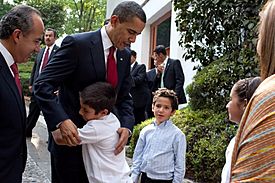
Early life and education
Felipe de Jesús Calderón Hinojosa was born in Morelia, Michoacán, Mexico on 18 August 1962. He is the youngest of five brothers and son of Carmen Hinojosa Calderón and the late Luis Calderón Vega.
His father was a co-founder of the National Action Party and an important political figure. The elder Calderón occupied state posts and served a term as federal deputy. He spent most of his life working within the party and spent most of his free time promoting the PAN. The young Calderón was active in his father's campaigns. As a boy, he distributed party pamphlets and flyers, rode PAN campaign vehicles and chanted slogans at rallies.
After growing up in Morelia, Calderón moved to Mexico City, where he received a bachelor's degree in law from the Escuela Libre de Derecho. Later, he received a master's degree in economics from the Instituto Tecnológico Autónomo de México (ITAM) and a Master of Public Administration degree in 2000 from the John F. Kennedy School of Government at Harvard University.
Following his father's example, he joined the PAN, with the desire of one day becoming Mexico's president. It was in the National Action Party that Calderón met his wife, Margarita Zavala, who served in Congress as a federal deputy. They have three children, María, Luis Felipe and Juan Pablo.
Calderón is Roman Catholic.
Political and social views
In his economic policy views, he supports balanced fiscal policies, flat taxes, lower taxes, and free trade.
He supported libertarian candidate Javier Milei in 2023 Argentine general election.
Political career
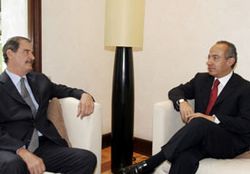
Calderón was president of the PAN's youth movement in his early twenties.
He was a local representative in the Legislative Assembly and, on two different occasions, in the federal Chamber of Deputies. He ran for the governorship of Michoacán in 1995 and served as national president of the PAN from 1996 to 1999. During his tenure, his party maintained control of 14 state capitals, but also faced a reduced presence in the federal Chamber of Deputies.
Soon after Vicente Fox took office as president, Calderón was appointed director of Banobras, a state-owned development bank. He was accused by political opponents of committing abuse, disputing use of certain legal procedures to finance property valued between three and five million Mexican pesos (between US$300,000 and $500,000); however, once political objections arose, he used other means to formalize his transaction.
He joined the presidential cabinet as Secretary of Energy, replacing Ernesto Martens. He left the post in May 2004 in protest of Vicente Fox's criticism of his presidential ambitions while supporting those of Santiago Creel.
2006 Presidential Campaign
Members of his party chose him as the PAN presidential candidate. In a series of three primary elections, he defeated the favored former Secretary of the Interior under President Vicente Fox, and thus the election of Calderón as party candidate surprised many analysts. The PAN pointed to his competitive primary election as a sign of internal democracy. In other major parties, there was one candidate or all strong candidates but one was eliminated.
Calderón's campaign gained momentum after the first presidential debate. Subsequent poll numbers put him ahead of López Obrador from March to May; some polls favored him by as much as 9 percentage points. This trend in his favor was contained after the second presidential debate when López Obrador decided to start joining the debates. Final poll numbers days ahead of the results indicated that his opponent's prior lead had shrunk further; some polls gave López Obrador the lead, while others favored Calderón and still, others indicated a technical tie.
Mexico Libre
After three decades of PAN membership, Calderón left the party on 11 November 2018 to found his own party, Free Mexico (México Libre), which sought to debut in the 2021 legislative elections. Its registration was rejected by the INE as the "origin of cash contributions was not accredited, violating principles in terms of oversight, transparency and accountability."
Presidency
Inauguration
| Presidential styles of Felipe Calderón |
|
|---|---|
| Reference style | Presidente de los Estados Unidos Mexicanos "President of the United Mexican States" |
| Spoken style | Presidente de Mexico "President of Mexico" |
| Alternative style | Señor Presidente "Mr. President" |
The Mexican Constitution states that the President must be inaugurated by taking the oath of office before Congress in the lower house, the Chamber of Deputies. The PRD opposition had threatened to not allow Calderón to take the oath of office and be inaugurated as president. Ahead of claims that the PRD would disrupt the precedings, the PAN took control of Congress's main floor three days before the inauguration was scheduled.
On 30 November 2006, outgoing President Vicente Fox Quesada and still President-elect Felipe Calderón Hinojosa stood side by side on national television as Fox turned over the presidential sash to a cadet, who handed it to Calderón. Afterwards, Fox read a short speech indicating that he had concluded his mandate by receiving the flag "that had accompanied him during the last six years which he had devoted himself completely to the service of Mexico and had the utmost honor of being the president of the republic". Calderón then made a speech to the Mexican public indicating that he would still attend the inauguration ceremony at the Chamber of Deputies. He made a call to unity.
Calderón's inauguration ceremony on 1 December at the Congress of the Union was tense and lasted less than five minutes, as he barely managed to recite the oath of office while the PRD legislators shouted in protest against the alleged electoral fraud and attempted to impede his inauguration, and afterward he quickly left the building for security reasons as some of the legislators engaged in violent brawls. Besides the claims of fraud, Calderón took office with the smallest percentage of votes for a winning presidential candidate in Mexican history (35.8%).
Calderón's cabinet
| Portfolio | Minister | Took office |
Left office |
||||||
|---|---|---|---|---|---|---|---|---|---|
| President | Felipe Calderón | 2006 | 2012 | ||||||
| Secretary of Interior | Francisco Ramírez Acuña | 2006 | 2008 | ||||||
| Juan Camilo Mouriño* | 2008 | 2008 | |||||||
| Fernando Gómez-Mont | 2008 | 2010 | |||||||
| Francisco Blake Mora* | 2010 | 2011 | |||||||
| Chancellor | Patricia Espinosa | 2006 | 2012 | ||||||
| Secretary of Finance | Agustín Carstens | 2006 | 2009 | ||||||
| Ernesto Cordero | 2009 | 2011 | |||||||
| José Antonio Meade | 2011 | 2012 | |||||||
| Secretary of Defense | Guillermo Galván Galván | 2006 | 2012 | ||||||
| Secretary of the Navy | Mariano Saynez | 2006 | 2012 | ||||||
| Secretary of Economy | Eduardo Sojo | 2006 | 2008 | ||||||
| Gerardo Ruiz Mateos | 2008 | 2010 | |||||||
| Bruno Ferrari | 2010 | 2012 | |||||||
| Secretary of Social Development |
Beatriz Zavala | 2006 | 2008 | ||||||
| Ernesto Cordero | 2008 | 2009 | |||||||
| Heriberto Félix Guerra | 2009 | 2012 | |||||||
| Attorney General | Eduardo Medina-Mora | 2006 | 2009 | ||||||
| Arturo Chávez | 2009 | 2011 | |||||||
| Marisela Morales | 2011 | 2012 | |||||||
| Secretary of Public Security | Genaro García Luna | 2006 | 2012 | ||||||
| Secretary of Communications and Transportation |
Luis Téllez | 2007 | 2009 | ||||||
| Juan Molinar Horcasitas | 2009 | 2011 | |||||||
| Dionisio Pérez-Jácome | 2011 | 2012 | |||||||
| Secretary of Labor | Javier Lozano | 2006 | 2011 | ||||||
| Rosalinda Vélez Juárez | 2011 | 2012 | |||||||
| Secretary of Environment | Rafael Elvira Quesada | 2006 | 2012 | ||||||
| Secretary of Energy | Georgina Kessel | 2006 | 2011 | ||||||
| José Antonio Meade | 2011 | 2011 | |||||||
| Jordy Herrera Flores | 2011 | 2012 | |||||||
| Secretary of Agriculture | Alberto Cárdenas | 2006 | 2009 | ||||||
| Francisco Mayorga | 2009 | 2012 | |||||||
| Secretary of Education | Josefina Vázquez Mota | 2006 | 2009 | ||||||
| Alonso Lujambio | 2009 | 2012 | |||||||
| José Ángel Córdova | 2012 | 2012 | |||||||
| Secretary of Health | José Ángel Córdova | 2006 | 2011 | ||||||
| Salomón Chertorivski | 2011 | 2012 | |||||||
| Secretary of Tourism | Rodolfo Elizondo | 2006 | 2010 | ||||||
| Gloria Guevara | 2010 | 2012 | |||||||
| Secretary of Agrarian Reform | Abelardo Escobar Prieto** | 2006 | 2012 | ||||||
| Legal Counsellor | Daniel Cabeza de Vaca | 2006 | 2008 | ||||||
| Miguel Alessio | 2008 | 2012 | |||||||
| *Died in office **Retained from previous administration |
|||||||||
Domestic policy
During his first months of government, President Calderón took several actions, such as introducing the Tortilla Price Stabilization Pact and a cap on the salaries of public servants, described politically as "seeking to fulfill a campaign promise to incorporate the agenda of election rival Andrés Manuel López Obrador into his government."
Calderón created the largest number of universities (96) in the history of Mexico. He was also the only president who granted full coverage and a secure spot in elementary schools to children from 6 to 11 years old. The Office of Social Aid for Victims of Violence (in Spanish: Procuraduría Social para Víctimas de la Violencia) was created by him in 2011. During Calderón's administration, more than 1,000 hospitals were created, and more than 2,000 were reconstructed and amplified. During Vicente Fox's administration, only 40 million people had access to a public health care system. Currently, more than 100 million Mexicans have access to their country's health care system due to Calderón's effort to implement a universal health care system. Moreover, Calderón created more than 16,500 kilometers of interstate highways. Calderón also dispatched military forces all over Mexico since the beginning of his presidency to put down the drug cartels and the increasing violence generated by the criminal organizations that fight with rival groups for territory.
Health policy
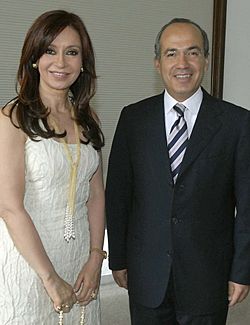
The administration's move towards universal healthcare coverage remains one of the most popular policies of the administration. He launched Seguro Popular to make this policy a reality. Through his policies, significant health infrastructure has been built and access expanded in many areas of the country, while the costs have been lowered significantly for many people to the point that many medicines have already been distributed free of charge.
The 2009 Swine Flu epidemic struck Mexico and was labeled a pandemic by the World Health Organization. The administration declared a state of emergency and acted firmly in giving open information to the world about the swine flu epidemic, and it acted with tough measures to contain its spread by shutting down many public services including schools. President Calderón appeared on television explaining the situation and demonstrating basic precautionary measures to take during the epidemic such as coughing into one's elbow rather than into the air. Tamiflu and vaccines were used in 2009 and in 2010 during flu season, and some deaths were undoubtedly prevented by the strong measures that were taken as well as due to a reduction in the spread and severity of the disease. Policies keeping people home and awareness of effective strategies may have helped prevent virulent forms of the virus from spreading as easily as minor forms that were harder to detect and identify. Criticism of Calderón's handling varied from early claims that his administration was not doing enough to later claims that the administration had exaggerated the measures that it had taken.
The Mexican Genome Project was initiated by Calderón's administration in part as a response to the swine flu outbreak and to safeguard the discovering of genetic markers that will better target and assist Mexico's 100+ million people in regards to prevention and treatment of diseases and other health concerns such as diabetes. A study on the efficacy of the project confirmed, according to Dr. Jiménez-Sánchez, that "It is not possible today to say genetic variation is responsible for the unique H1N1 Influenza A mortality rate in Mexico. However, knowledge of genomic variability in the Mexican population can allow the identification of genetic variations that confer susceptibility to common diseases, including infections such as the flu." "It will also help develop pharmacogenomics to help produce medicines tailored to people of a specific genetic group, to the creation of drugs that are both safer and more effective." Calderón commended the achievement: "The genomic map of the Mexican population is an essential contribution of Mexico to science and public health. This study represents an important landmark to develop genomic medicine in Mexico to improve healthcare of its population. I commend our National Institute of Genomic Medicine, INMEGEN, for such a significant milestone."
Domestic environmental policy
Felipe Calderón's administration raised awareness of environment issues including deforestation and climate change through various policy measures such as planting over 8 million trees and attracting green-technology companies to Mexico. Mexico also achieved a significant reduction in deforestation. This includes $2.5 billion investment in wind farms.
Economic policy
The country's total GDP on a purchasing-power-parity basis is the 11th largest in the world as of 2011[update] and public policy now seeks to create quality jobs, reduce poverty and protect the standard of living of all classes. The administration has worked to attract investment, diversify the economy away from over-reliance on oil and the US market, upgrade infrastructure that has not kept up with the demands of the large economy, add jobs, reduce poverty, provide for a large middle class and reduce inequality. In keeping with its protection of the purchasing power of those least able to shield themselves through the use of financial instruments, the administration has succeeded in keeping prices and interest rates relatively low and stable even during the Great Recession and European debt crisis, while also avoiding the currency crashes of the 1980s and 1990s. The Mexican economy has been growing more quickly than the US economy during all but one year of the administration, even as US growth has been sluggish.
Infrastructure
The administration has accelerated the building of public works projects and allocated federal funds towards infrastructure such as roads and bridges as an investment in the country's future growth.
In 2012, the massive Baluarte Bridge was inaugurated, which speeds travel between Mazatlán and Durango and allows for faster access between Mexico's coasts. The Baluarte Bridge is so high that the Eiffel Tower could fit under its central span.
Investment
Through investments in infrastructure and free trade agreements, the administration won investments from many auto companies that decided to build factories in Mexico and expand existing facilities and models produced in Mexico. Mexico has become one of the top auto manufacturers in the world and for two years in a row far exceeded the previous records of auto production and export. The total foreign direct investment during Calderón's presidency was US$70.494 billion.
Mexico also has a nascent aeronautics and aviation industry and large electronics and consumer goods industries, all of which have been attracting significant investment capital and higher-value manufacturing for a skilled workforce. Heineken made significant investments in Mexico's beverage industry during this administration.
Trade
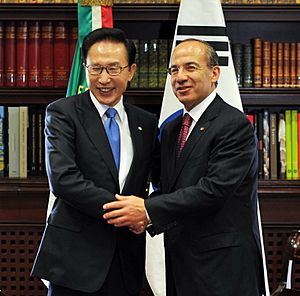
In a move to expand new export opportunities that attract employment and diversify Mexico's crucial export sector away from excessive dependence on the US market, Mexico also expanded its trade accords beyond the US borders and sought to increase trade with the European Union, East Asia and Latin America. It was hoped that new infrastructure would help diversify Mexico's economy and improve stability in years to come. One new cooperative accord between major Latin American nations on the Pacific coast, called PaCiFiCa by the Economist, has helped to isolate the participating nations from some of the fluctuations stemming from the European debt crisis as it looks towards greater trade with Asian nations. Mexico maintains positive trading relationships and trade discussions throughout the world so as to make Mexico an open economy with a growing number of trade opportunities for all regions of Mexico and aided by new infrastructure.
Tortilla Price Stabilization Pact
The international price of corn rose dramatically throughout 2006, leading to the inflation of tortilla prices in the first month of Calderón's term. Because tortillas are the main food product consumed by the country's poorest, national concerns over the rising prices immediately generated political pressure on Calderón's administration.
The president opted to use price ceilings on tortillas that protected local consumers of corn. This price control came in the form of the Tortilla Price Stabilization Pact between the government and many of the main tortilla producing companies, including Grupo Maseca and Bimbo, to put a price ceiling at 8.50 pesos per kilogram of tortilla. The hope was that a ceiling on corn prices would provide incentive for the market to lower all prices nationally.
Critics argue that the pact was both nonbinding and a de facto acceptance of a maximum 30% increase in the price of that product (from 5.95 pesos per kilogram to 8.50 pesos per kilogram). Some tortillerías ignored the agreement, leading to price increases well in excess of the 8.50 pesos. Government opposition argued that this was an indication of the failure to protect the interests of its poor citizens. However, several major supermarkets, such as Soriana and Comercial Mexicana, sell the tortillas at a lower price than the one in the agreement – as low as 5.10 pesos per kilogram – which is interpreted opponents to price controls as clear evidence that price controls and the Tortilla Price Stabilization Pact were unnecessary. Additionally, PROFECO, a consumer protection government organization, has also threatened with jail those tortilla producers who charge "excessive" prices.
Guillermo Ortiz, governor of the Bank of Mexico, labeled the agreement "a success" for consumers and urged for it to continue as means to combat rising inflation.
First Employment Program
Fulfilling an electoral promise, President Calderón launched the First Employment Program, which aims to create new opportunities for people entering the job market. The program will give cash incentives to companies for hiring first-time job holders, including young people graduating from higher education and millions of women who have never worked.
The program has been interpreted as an effort to stop immigration into the United States. Immigration to the United States has been reduced, but many complex factors are involved including the US slowdown since 2008.
Reactions to this program have been mixed. The president of the Mexican Association of Directors in Human Relations, Luis García, has anticipated a positive effect and even showed Nextel's subsidiary in Mexico as an example for hiring 14% of its new workforce in 2006 as people in their "first employment". Secretary of Labor Javier Lozano Alarcón has admitted that the program by itself will be insufficient to create as many new jobs as needed and has called for deeper reforms to allow for further investment.
Public servants salary cap
President Calderón introduced, on his first day as president, a presidential decree limiting the president's salary and that of cabinet ministers. The measure excludes much of the bureaucracy and public servants in the legislative or judicial branches. According to a Freedom of Information Act request filed by Reforma, the decree will affect 546 high-level government officials and save the government about US$13 million. The opposition has stated that the 10% reduction in salary as not being comprehensive enough.
Like his opponent in the 2006 election, Calderón also proposed laws that, if passed, would lower salaries for public servants in all three branches of government and impose a cap on compensation. The proposal also includes measures to make the remuneration of public servants more transparent and subject to fiscalization.
Foreign policy
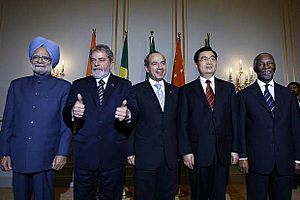
It was expected that Calderón would continue with the foreign policy started during Fox's term, known as the Castañeda Doctrine, abandoning of the Estrada Doctrine. He was expected to mediate with 'free market' Latin American countries.
Calderón had been a proponent of the Mesoamerican Integration and Development Project which was now merged with a similar funding and infrastructure project, the Puebla-Panama Plan (PPP), started during the Fox administration. Calderón expanded the Mesoamerican Integration and Development Project / PPP, now including Colombia, and an agreement of cooperation against organized crime. Jorge G. Castañeda, Secretary of Foreign Affairs during the first half of Fox's administration and proponent of the "Castañeda Doctrine", suggested that Calderón's leadership and the Mesoamerican Integration and Development Project / PPP should be used as a counterpart to Hugo Chávez's leadership of left-wing policies in Latin America. Calderón has stated that "the challenge (of the PPP) is to foster democratic practices with solid foundation in the region".
Another landmark was the proposed Mérida Initiative, a security cooperation initiative between the United States, the government of Mexico and the countries of Central America, with the aim of combating the threats of transnational crime.
International environmental policy
The Cancún Accord was a widely praised triumph credited to the deft handling by the Calderón and his team and received a standing ovation. Along with hosting and chairing the Cancún climate accord that reached agreements on targets and reaffirmed the agreement on compensating developing nations for damage from climate change, Mexico earned the G-20's trust and confidence to preside over the group during 2012, including a summit in Los Cabos.
Immigration reform
Felipe Calderón made immigration reform one of his main priorities, and in 2008 he and the Mexican Congress passed a bill decriminalizing undocumented immigration into Mexico. He expressed his hopes that something be done to clear up the status of undocumented Mexican immigrants in the US.
Before meeting with President Bush in March 2007, Calderón openly expressed his disapproval of building a wall between the two nations. After the U.S. Senate rejected the Comprehensive Immigration bill, President Calderón called the decision a "grave error".
Approval ratings
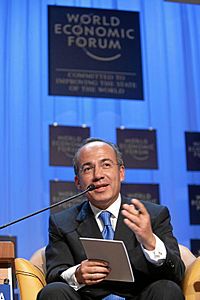
According to a poll by Grupo Reforma taken from 16 to 18 February 2007, Calderón's approval rating was 58%. In this poll, Mexicans interviewed give President Calderón and his actions a score of 6.6 out of 10. He is best rated in his actions on issues related to health and reducing crime (60% and 59% approval respectively), and worst rated on domestic and foreign policy (33% approval each).
A poll by Ipsos-Bimsa shows a change in Calderón's approval rating at 57% in November 2007.
In June 2008, Calderón's approval rating jumped to 64% before slipping to 62% in September.
According to a March 2010 poll by GEA-ISA, 45% of respondents approved of their president's performance, down seven points since November 2009 polling at 52%.
Polling firm Buendia & Laredo released a survey showing President Calderón's approval rating at 54% on 9 May 2011.
On 27 February 2012, a poll by El Universal showed a 58% approval rating with only 11% disapproval, a decrease in concern for security from 48% to 33% polled listing security as the top concern facing the government, 42% say things have improved in Mexico since Felipe Calderón's administration, 21% said things have stayed the same, while 34% said things have gotten worse.
Grupo Reforma's poll published between 22 and 26 March 2012 noted that Calderón had an approval rate of 66% among 1,515 people.
Consulta Mitofsky published a study on 23 August 2012 which concluded that after 22 trimesters the approval of Felipe Calderón fell to 46%. He ended his presidency with high approval ratings with 64% approving his administration, while 25% disapproved his administration.
Honors
Throughout his office, Calderón has been awarded several honors from foreign nations.
 Belize:
Belize:
 Brazil:
Brazil:
 National Order of the Southern Cross (Grand Collar - Grande Colar) (7 August 2007)
National Order of the Southern Cross (Grand Collar - Grande Colar) (7 August 2007)
 Chile:
Chile:
 Denmark:
Denmark:
 Knight of the Order of the Elephant (18 February 2008)
Knight of the Order of the Elephant (18 February 2008)
 El Salvador:
El Salvador:
 Guatemala:
Guatemala:
 Spain:
Spain:
 Knight of the Collar of the Order of Isabella the Catholic (6 June 2008)
Knight of the Collar of the Order of Isabella the Catholic (6 June 2008) Collar of the Order of Civil Merit (15 November 2012)
Collar of the Order of Civil Merit (15 November 2012)
 United Kingdom:
United Kingdom:
 Honorary Knight Grand Cross of the Order of the Bath (30 March 2009)
Honorary Knight Grand Cross of the Order of the Bath (30 March 2009)
Awards
- WEF Global Leadership Statesmanship Award, World Economic Forum, January 2012
- "People Who Mattered", Time, 2010.
- "The World's 50 Most Influential Figures 2010" by New Statesman, September 2010
- "Bravo Business Awards Leader of the Year", Latin Trade, October 2009.
- "Leader of the Year", Latin Business Chronicle, 17 December 2007.
- Honorary Chair of the Global Commission for the Economy and Climate
Images for kids
-
President Calderón and President of Brazil Luiz Inácio Lula da Silva with members of the Mexican Army in the background
See also
 In Spanish: Felipe Calderón para niños
In Spanish: Felipe Calderón para niños



